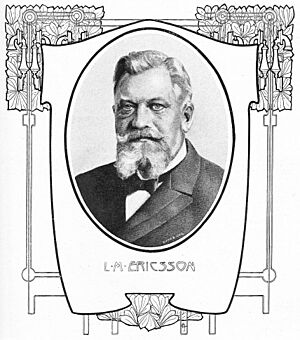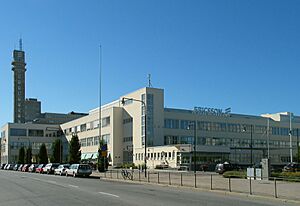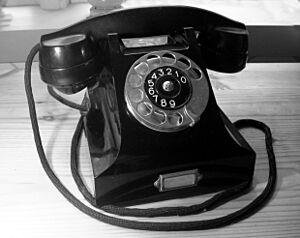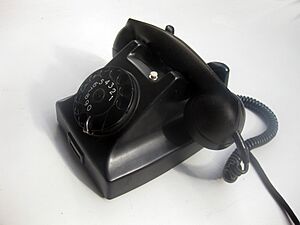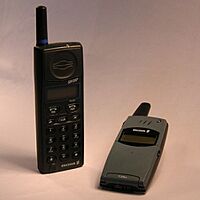Ericsson facts for kids
 |
|
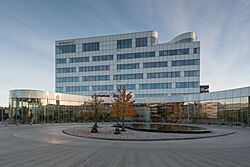
Ericsson's headquarters in Kista, Stockholm
|
|
| Public | |
| Traded as |
|
| ISIN | [https://kids.kiddle.co/index.php?title=Toollabs:isin/&language=de&isin=%3Cdiv+class%3D%22plainlist+%22+%3E%0A%2A+%5B%5BInternational+Securities+Identification+Number%7CISIN%5D%5D%3A+%5Bhttps%3A%2F%2Fisin.toolforge.org%2F%3Flanguage%3Den%26isin%3DSE0000108649+SE0000108649%5D%0A%2A+%5B%5BInternational+Securities+Identification+Number%7CISIN%5D%5D%3A+%5Bhttps%3A%2F%2Fisin.toolforge.org%2F%3Flanguage%3Den%26isin%3DSE0000108656+SE0000108656%5D%0A%0A%3C%2Fdiv%3E
|
| Industry | |
| Founded | Stockholm, Sweden (1876) |
| Founder | Lars Magnus Ericsson |
| Headquarters | Kista, Stockholm, Sweden |
|
Area served
|
Worldwide |
|
Key people
|
|
| Products | Mobile and fixed broadband networks, consultancy and managed services, TV and multimedia technology |
| Revenue | |
|
Operating income
|
|
| Total assets | |
| Total equity | |
| Owners |
|
|
Number of employees
|
|
| Subsidiaries |
|
Telefonaktiebolaget LM Ericsson, usually called Ericsson, is a big Swedish company. It works with telecommunications all over the world. Ericsson is known for helping to create the modern phone industry. It is also a leader in developing 5G technology.
Ericsson has invented many things, including Bluetooth technology. The company owns over 57,000 patents. Ericsson sells equipment, software, and services for phone companies and businesses. This includes 4G and 5G mobile equipment. The company has about 100,000 employees. They work in more than 180 countries. Ericsson's shares are traded on the Nasdaq Stockholm and the American Nasdaq stock exchanges.
The company was started in 1876 by Lars Magnus Ericsson. It is mainly controlled by the Wallenberg family and the Handelsbanken bank. These groups gained control of Ericsson in the 1930s.
Contents
History of Ericsson
How Ericsson Started
Lars Magnus Ericsson began his journey with telephones when he was young. He worked as an instrument maker. In 1876, at 30 years old, he opened a shop in Stockholm. He repaired telephones made by other companies. By 1878, Ericsson started making and selling his own telephone equipment. His company soon agreed to provide phones and switchboards to Sweden's first phone company.
Growing Around the World

As Ericsson made more phones in the late 1890s, the Swedish market became full. So, Ericsson started selling its products in other countries. The United Kingdom and Russia were some of the first places. Factories were later built in these countries. This helped Ericsson get more local contracts. By 1897, 28% of Ericsson's products were sold in the UK. Countries in the Nordic region also became customers.
Ericsson products also reached Australia and New Zealand. These became Ericsson's biggest markets outside Europe. Phones were now made in large numbers. They started to look simpler and less decorated. Even with success elsewhere, Ericsson did not sell much in the United States. Other companies like Western Electric and Kellogg already controlled that market. Lars Ericsson left the company in 1901.
Automatic Phone Systems
For a while, Ericsson focused on manual phone systems. They made their first dial telephone in 1921. But it took time for automatic systems to become popular. Phones from this time had a simpler look. Many early automatic phones still looked like older models. They had a dial on the front. World War I and the Great Depression slowed the company's growth. Sales to other countries dropped by about half.
Changes in Ownership
Buying other phone companies put a strain on Ericsson's money. In 1925, Karl Fredric Wincrantz took control of the company. He bought most of its shares. The company's name was changed to Telefonaktiebolaget L M Ericsson.
The Wallenberg Family Takes Over
Ericsson was saved from going out of business by banks. These included Stockholms Enskilda Bank, which is now Skandinaviska Enskilda Banken. The Wallenberg family controlled some of these banks. Marcus Wallenberg Jr. helped make a deal to fix Ericsson's money problems. The banks slowly gained more shares in Ericsson. By 1960, the Wallenberg family bought all the shares from another company, ITT. Since then, the Wallenberg family has controlled Ericsson.
Developing the Market
In the 1920s and 1930s, governments started to organize phone markets. Many small, private phone companies were combined. Ericsson gained some of these new contracts. This meant more sales of equipment. Almost one-third of Ericsson's sales came from its own phone operating companies.
More Innovations
Ericsson launched the world's first fully automatic mobile phone system in 1956. It was called MTA. In the 1960s, they released one of the first hands-free speakerphones. In 1954, they introduced the Ericofon, a famous one-piece phone. Ericsson's crossbar switching equipment was used in many countries. In 1983, the company launched the ERIPAX network products.
The Internet Age (1995–2003)
In the 1990s, as the internet grew, Ericsson was a bit slow to see its importance. But the company started an internet project in 1995. This project was called Infocom Systems. It aimed to use new opportunities from fixed-line telecom and IT.
The GSM mobile standard became very popular worldwide. By early 1997, Ericsson had about 40% of the world's mobile market. This meant around 54 million mobile users. Phone and chip companies worked to bring internet to mobile phones. Early versions like Wireless Application Protocol (WAP) used existing GSM networks. These were called 2.5G services. However, they were basic and not very successful.
The International Telecommunication Union (ITU) created rules for 3G mobile services. Ericsson strongly supported the WCDMA version, which was based on the GSM standard. They started testing it in 1996. Japanese company NTT Docomo partnered with Ericsson and Nokia to support WCDMA. DoCoMo was the first to launch a 3G network. Ericsson was a key developer of WCDMA. Another company, Qualcomm, promoted a different system called CDMA2000. This led to a patent lawsuit. In 1999, they agreed to pay each other for using their technologies. Ericsson also bought Qualcomm's wireless business.
In 2001, Ericsson faced financial challenges. Sales to phone companies dropped by half. Their phone unit lost a lot of money. A fire at a chip factory in 2000 also hurt Ericsson's phone production. In October 2001, Ericsson combined its mobile phone business with Sony. This new company was called Sony Ericsson Mobile Communications.
Ericsson had to make many changes. They cut jobs and raised money. From 2001 to 2003, the number of employees dropped from 107,000 to 54,000. The company survived as mobile internet began to grow.
Rebuilding and Growth (2003–2018)
The rise of full mobile internet led to a period of growth for the telecom industry. This included Ericsson. After 3G services launched in 2003, more people started using the internet on their phones.
Ericsson worked to improve WCDMA, which was the first 3G technology. New improvements included High-Speed Packet Access (HSPA). This technology provided the world's first mobile broadband. It spread quickly from 2005 to 2006.
In July 2016, Hans Vestberg stepped down as Ericsson's CEO. Börje Ekholm became the new CEO on January 16, 2017.
Buying Other Companies and Working Together
Around 2000, companies and governments pushed for mobile internet standards. In May 2000, the European Commission created a group called the Wireless Strategic Initiative. It included Ericsson, Nokia, Alcatel, and Siemens. They worked together to develop new wireless systems. Later that year, they invited other companies to join them. In December 1999, Microsoft and Ericsson announced a partnership. They planned to combine Microsoft's web software with Ericsson's mobile internet technology.
In 2000, the "Dot-com bubble" burst. This had a big impact on Sweden's economy. Ericsson, being the largest maker of mobile telecom equipment, cut thousands of jobs. In the same year, Intel signed a $1.5 billion deal to supply memory chips to Ericsson.
The partnership between Ericsson and Microsoft was short-lived. It ended in October 2001. In the same month, Ericsson and Sony created Sony Ericsson Mobile Communications. This company made mobile phones. Ten years later, in February 2012, Ericsson sold its share in the joint company. Ericsson wanted to focus on the global wireless market.
Many telecom companies faced challenges in 2001. Ericsson's global workforce decreased from 107,000 to 85,000. In September 2001, Ericsson bought the remaining shares of EHPT from Hewlett-Packard. EHPT was a joint company started in 1993.
In 2002, many companies in the information and communication technology (ICT) sector lost a lot of money. Share prices fell sharply. More than half a million people lost their jobs in the global telecom industry. Ericsson laid off 20,000 more staff. They also raised about $3 billion from shareholders. In June 2002, Infineon Technologies bought Ericsson's microelectronics unit.
Ericsson helped launch the .mobi internet address in 2005. This address was made for the mobile internet.
Ericsson continued to work with Hewlett-Packard. In 2003, Ericsson outsourced its IT services to HP. This contract was extended in 2008. In October 2005, Ericsson bought most of the UK company Marconi Company. This included its famous brand name. In September 2006, Ericsson sold most of its defense business, Ericsson Microwave Systems, to Saab AB.
In 2007, Ericsson bought Redback Networks, which made internet routers. They also bought Entrisphere, a US company with fiber-access technology. In September 2007, Ericsson bought a large part of LHS, a German software firm. In 2008, Ericsson sold its business phone system division to Aastra Technologies. They also bought Tandberg Television, a TV technology company.
In 2009, Ericsson bought the CDMA2000 and LTE business from Nortel. They also bought Bizitek, a Turkish company, and Elcoteq's manufacturing operations in Estonia. In 2010, Ericsson acquired parts of inCode, a consulting company. They also bought Nortel's share in LG-Nortel, now called Ericsson-LG. Other acquisitions included Optimi Corporation and Pride.
In 2011, Ericsson acquired manufacturing facilities and staff from Guangdong Nortel. They also bought Nortel's Multiservice Switch business. In January 2012, Ericsson acquired Telcordia Technologies, a company that makes operations and business support systems. In March, Ericsson announced it was buying the broadcast-services division of Technicolor. In April 2012, Ericsson completed the purchase of BelAir Networks, a Wi-Fi network company.
On May 3, 2013, Ericsson announced it would sell its power cable operations to NKT Holding. On July 1, 2013, Ericsson announced it would acquire Red Bee Media, a media management company. This deal was completed in May 2014. In September 2013, Ericsson completed its purchase of Microsoft's Mediaroom business. This made Ericsson the largest provider of IPTV and multi-screen services. It was renamed Ericsson Mediaroom. In September 2014, Ericsson bought a majority stake in Apcera. In October 2015, Ericsson bought Envivio, a software encoding company. In April 2016, Ericsson acquired the Polish and Ukrainian operations of Ericpol. About 2,300 Ericpol employees joined Ericsson.
In June 2017, Ericsson explored selling its media businesses. The Red Bee Media business stayed within Ericsson as a separate company. A majority stake of the Media Solution division was sold to One Equity Partners. The new company was named MediaKind. This deal was completed in January 2019. In February 2018, Ericsson acquired Placecast, a location-based mobile data company. In May 2018, SoftBank partnered with Ericsson to test new radio technology. In September 2020, Ericsson acquired Cradlepoint for $1.1 billion.
In November 2021, Ericsson announced it would acquire Vonage for $6.2 billion. This acquisition was completed in July 2022. In January 2024, Ericsson and MTN Group announced they would expand their partnership. This aims to boost mobile financial services in Africa. In December 2024, Ericsson secured a multi-year deal with Bharti Airtel. This deal is for providing 4G and 5G radio access network products.
How Ericsson is Managed
As of 2016, the board of directors of LM Ericsson included: Leif Johansson, Jacob Wallenberg, Kristin S. Rinne, Helena Stjernholm, Sukhinder Singh Cassidy, Börje Ekholm, Ulf J. Johansson, Mikael Lännqvist, Zlatko Hadzic, Kjell-Åke Soting, Nora Denzel, Kristin Skogen Lund, Pehr Claesson, Karin Åberg and Roger Svensson.
Research and New Ideas
Ericsson organizes its research and development (R&D) into different levels. This depends on when new products or technologies will be ready. Their R&D team works on many areas of network technology. These include wireless networks, broadband, and multimedia. They also focus on safety, security, and global services. Since 2012, Sara Mazur has been the head of research.
Ericsson works with many major universities and research centers. These include Lund University in Sweden and Beijing Institute of Technology in China. Ericsson also takes part in European research programs. The company holds 33,000 patents. They are a top holder of important patents for GSM/GPRS/EDGE, WCDMA/HSPA, and LTE. In 2023, the World Intellectual Property Organization (WIPO) ranked Ericsson 7th in the world for patent applications. They published 1,863 patent applications that year.
Ericsson has a program called Ericsson Developer Connection. It helps people create new apps and services. They also have Ericsson Labs for testing new apps and tools. The company holds internal competitions for its employees to come up with new ideas.
In May 2022, Ericsson and Intel announced they are working together. They are creating high-performing Cloud RAN solutions. They launched a tech hub in California, USA. This hub focuses on making Cloud RAN and Intel technology better. They aim to improve energy use and network performance.
Products and Services
Ericsson's work includes researching technology, developing network systems and software. They also help run operations for phone companies. Ericsson offers services for all major mobile communication standards. They have three main business units.
Networks Business
This unit develops network equipment for mobile and fixed connections. Their products include radio base stations and mobile switching centers. Phone companies use Ericsson products to upgrade their networks. They move from 2G to 3G, and now to 4G and 5G networks.
Ericsson's network division has helped develop 2G, 3G, 4G/LTE, and 5G technology. They also work on older technologies like GSM and WCDMA. Their network products include microwave transport and Internet Protocol (IP) networks. They also offer fixed-access services for copper and fiber. Their radio access networks range from small pico cells to large macro cells.
Network Services
Ericsson's network rollout services help make changes to live networks. They use their own teams and other companies. They provide services like technology deployment, network upgrades, and support. They also help optimize networks to work better.
Digital Services Business
This unit provides core networks. It also offers Operations Support Systems (OSS) for managing networks and analyzing data. They also provide Business Support Systems (BSS) for things like billing. This unit also has an m-Commerce offering. It helps service providers work with banks and other financial groups. Ericsson has made m-commerce deals with Western Union and MTN.
Managed Services Business
This unit works in 180 countries. It provides managed services, systems integration, and consulting. They also help with network rollout, design, and optimization. They offer broadcast services, learning services, and support.
The company also works with television and media, public safety, and utility companies. Ericsson says it manages networks for over 1 billion phone users worldwide. They also support customer networks for more than 2.5 billion users.
Broadcast Services
Ericsson's Broadcast Services unit became a company called Red Bee Media. It is now a joint venture. This unit handles the broadcasting of live and recorded TV shows. This includes showing commercials and public service programs. They also provide services like subtitles, audio description, and sign language interpreters. Their media management services help prepare and deliver media over the internet.
Businesses Ericsson No Longer Owns
Sony Ericsson Mobile Communications AB (Sony Ericsson) was a joint company with Sony. It combined the mobile phone businesses of both companies. It made mobile phones, accessories, and PC cards. Sony Ericsson was in charge of designing products, marketing, sales, and customer service. On February 16, 2012, Sony bought all of Ericsson's share in Sony Ericsson. The company then changed its name to Sony Mobile Communications. About a year later, it moved its headquarters from Sweden to Japan.
Mobile Phones
When Sony Ericsson was formed in 2001, Ericsson's mobile phone production moved to that company. Here is a list of mobile phones sold under the Ericsson brand name before that:
- Ericsson GS88 – A phone that was planned but never released. Ericsson invented the "Smartphone" name for it.
- Ericsson GA628 – Known for its Z80 CPU.
- Ericsson SH888 – The first mobile phone with wireless modem features.
- Ericsson A1018 – A dual-band phone that was easy to modify.
- Ericsson A2618 & Ericsson A2628 – Dual-band phones with a graphical LCD display.
- Ericsson PF768
- Ericsson GF768
- Ericsson DH318 - An early TDMA/AMPS phone in the USA.
- Ericsson GH388
- Ericsson T10 – A colorful phone.
- Ericsson T18 – The business version of the T10.
- Ericsson T28 – A very thin phone. It used special lithium polymer batteries.
- Ericsson T20s
- Ericsson T29s – Similar to the T28s, but with WAP support.
- Ericsson T29m – An early test version for the T39m.
- Ericsson T36m – A test version for the T39m. It was announced in yellow and blue. It was never released because the T39m came out.
- Ericsson T39 – Similar to the T28, but with GPRS internet, Bluetooth, and triple band support.
- Ericsson T65
- Ericsson T66
- Ericsson T68m – The first Ericsson phone with a color screen. It was later called Sony Ericsson T68i.
- Ericsson R250s Pro – A phone that was fully resistant to dust and water.
- Ericsson R310s
- Ericsson R320s
- Ericsson R320s Titan – A special edition with a titanium front.
- Ericsson R320s GPRS – A test phone for GPRS networks.
- Ericsson R360m – An early test version for the R520m.
- Ericsson R380 – The first phone to use the Symbian OS operating system.
- Ericsson R520m – Similar to the T39, but in a candy bar shape. It had features like a built-in speakerphone.
- Ericsson R520m UMTS – A test phone for UMTS networks.
- Ericsson R520m SyncML – A test phone for SyncML.
- Ericsson R580m – Announced in some news releases. It was supposed to be a newer version of the R380s.
- Ericsson R600
Telephones
- Ericsson Dialog
- Ericofon
Ericsson Mobile Platforms
Ericsson Mobile Platforms existed for eight years. In February 2009, Ericsson announced it would combine this unit with ST-NXP Wireless. This created a new company owned equally by Ericsson and STMicroelectronics. This joint company was later sold in 2013. The remaining work is now part of Ericsson Modems and STMicroelectronics.
Ericsson Enterprise
Starting in 1983, Ericsson Enterprise provided communication systems for businesses, public groups, and schools. It made products for voice over Internet protocol (VoIP) phone systems, wireless local area networks (WLAN), and mobile intranets. Ericsson Enterprise mainly worked from Sweden. In 2008, it was sold to Aastra.
See also
- Cedergren
- Damovo
- Ericsson Nikola Tesla
- Erlang (programming language)
- Investor AB
- List of networking hardware vendors
- List of Sony Ericsson products
- Red Jade
- Tandberg Television


